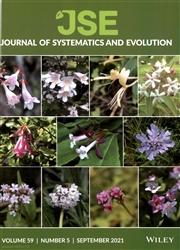多组学揭示 Suaeda salsa 盐生植物基因组进化和甜菜苷生物合成的奥秘
IF 2.9
1区 生物学
Q1 Agricultural and Biological Sciences
引用次数: 0
摘要
作为黄河三角洲重要的卤叶植物,苋科 C3 Suaeda salsa (L.) Pall.因其 "红地毯 "景观而备受关注,根据肉质叶片中贝特氰含量的不同,可将其简单分为红色和绿色两种表型。然而,莎莎尚未进行测序,这限制了人们在分子水平上对该物种的了解。我们结合高通量测序、PacBio单分子实时测序和Hi-C测序技术,构建了高质量染色体组规模的参考基因组,基因组大小为445.10 Mb,等位基因N50为2.94 Mb。通过对莎莎鱼基因组的注释,共鉴定出298.76 Mb的重复序列和23 965个编码蛋白质的基因,其中重复序列中长末端重复类型的比例最高,约占莎莎基因组的50.74%。比较基因组学表明,莎草属植物在距今约1.4615亿年前经历了一次全基因组复制事件,估计莎草属植物与Suaeda aralocaspica的分化时间约为16.9Ma。在两种表型中,共鉴定并纯化了四种贝壳杉素,包括贝壳杉素Ⅱ、芹菜素Ⅱ、苋菜素和6′-O-丙二酰基芹菜素Ⅱ,而两种显著上调的贝壳杉素(芹菜素Ⅱ和苋菜素)可能是红色表型中红色的主要原因。此外,我们还对两种表型进行了转录组学和代谢组学研究,以探索色素合成的分子机制,并筛选出了一系列与辣木籽苷产生有关的结构基因和转录因子。本文章由计算机程序翻译,如有差异,请以英文原文为准。
Multi‐omics provides insights into genome evolution and betacyanin biosynthesis in halophyte of Suaeda salsa
As an important halophyte in the Yellow River Delta, the Amaranthaceae C3 Suaeda salsa (L.) Pall. has attracted much attention for the “red carpet” landscape, and could be simply divided into red and green phenotypes according to the betacyanin content in the fleshy leaves. However, S. salsa has not been sequenced yet, which limited people's understanding of this species at the molecular level. We constructed a high‐quality chromosome‐scale reference genome by combining high‐throughput sequencing, PacBio single molecule real‐time sequencing, and Hi‐C sequencing techniques with a genome size of 445.10 Mb and contigs N50 of 2.94 Mb. Through the annotation of the S. salsa genome, 298.76 Mb of the repetitive sequences and 23 965 protein‐coding genes were identified, of which the proportion of long terminal repeats type in the repetitive sequences was the most abundant, about 50.74% of the S. salsa genome. Comparative genomics indicated that S. salsa underwent a whole‐genome duplication event about 146.15 million years ago (Ma), and the estimated divergence time between S. salsa and Suaeda aralocaspica was about 16.9 Ma. A total of four betacyanins including betanidin, celosianin II, amaranthin and 6′‐O‐malonyl‐celosianin II were identified and purified in both phenotypes, while two significantly up‐regulated betacyanins (celosianin II and amaranthin) may be the main reason for the red color in red phenotype. In addition, we also performed transcriptomics and metabolomics in both phenotypes to explore the molecular mechanisms of pigment synthesis, and a series of structural genes and transcription factors concerning with betacyanin production were selected in S. salsa .
求助全文
通过发布文献求助,成功后即可免费获取论文全文。
去求助
来源期刊

Journal of Systematics and Evolution
Agricultural and Biological Sciences-Ecology, Evolution, Behavior and Systematics
CiteScore
7.40
自引率
8.10%
发文量
1368
审稿时长
6-12 weeks
期刊介绍:
Journal of Systematics and Evolution (JSE, since 2008; formerly Acta Phytotaxonomica Sinica) is a plant-based international journal newly dedicated to the description and understanding of the biological diversity. It covers: description of new taxa, monographic revision, phylogenetics, molecular evolution and genome evolution, evolutionary developmental biology, evolutionary ecology, population biology, conservation biology, biogeography, paleobiology, evolutionary theories, and related subjects.
 求助内容:
求助内容: 应助结果提醒方式:
应助结果提醒方式:


